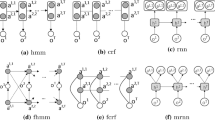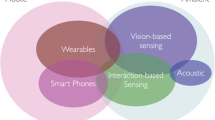Abstract
Activity recognition in smart environments is an evolving research problem due to the advancement and proliferation of sensing, monitoring and actuation technologies to make it possible for large scale and real deployment. While activities in smart home are interleaved, complex and volatile; the number of inhabitants in the environment is also dynamic. A key challenge in designing robust smart home activity recognition approaches is to exploit the users’ spatiotemporal behavior and location, focus on the availability of multitude of devices capable of providing different dimensions of information and fulfill the underpinning needs for scaling the system beyond a single user or a home environment. In this paper, we propose a hybrid approach for recognizing complex activities of daily living (ADL), that lie in between the two extremes of intensive use of body-worn sensors and the use of ambient sensors. Our approach harnesses the power of simple ambient sensors (e.g., motion sensors) to provide additional ‘hidden’ context (e.g., room-level location) of an individual, and then combines this context with smartphone-based sensing of micro-level postural/locomotive states. The major novelty is our focus on multi-inhabitant environments, where we show how the use of spatiotemporal constraints along with multitude of data sources can be used to significantly improve the accuracy and computational overhead of traditional activity recognition based approaches such as coupled-hidden Markov models. Experimental results on two separate smart home datasets demonstrate that this approach improves the accuracy of complex ADL classification by over 30 %, compared to pure smartphone-based solutions.






















Similar content being viewed by others
Notes
We interchangeably use Context as a state s in our HMM model. For brevity we denote \(Context^i(t)=s_t\) and \(Context^j(t) = s_t^{'}\) in equations.
References
Acampora G, Cook D, Rashidi P, Vasilakos A (2013) A survey on ambient intelligence in healthcare. Proc IEEE 101(12):2470–2494
Activity Recognition Challenge (2013). http://www.opportunity-project.eu/challengeDataset. Accessed June 2013
Activity Recognition Code (2014). http://ailab.wsu.edu/casas/ar/. Accessed Jan 2014
Alam M, Pathak N, Roy N (2015) Mobeacon: an iBeacon-assisted smartphone-based real time activity recognition framework. In: Proceedings of the 12th international conference on mobile and ubiquitous systems: computing, networking and services (in press)
Alam M, Roy N (2014) Gesmart: a gestural activity recognition model for predicting behavioral health. In: Proceeding of the IEEE international conference on smart computing
Almashaqbeh G, Hayajneh T, Vasilakos A, Mohd B (2014) QoS-aware health monitoring system using cloud-based WBANs. J Med Syst 38(10):121
Android Wear: Information that Moves with You (2015). http://googleblog.blogspot.co.uk/2014/03/sharing-whats-up-our-sleeve-android.html. Accessed Jan 2015
Bergmann J, McGregor A (2011) Body-worn sensor design: what do patients and clinicians want? Ann Biomed Eng 39(9):2299–2312
Brand M (1996) Coupled hidden Markov models for modeling interacting processes. Technical report 405, MIT Lab for Perceptual Computing
Chavarriaga R, Sagha H, Calatroni A, Digumarti S, Trster G, Milln J, Roggen D (2013) The opportunity challenge: a benchmark database for on-body sensor-based activity recognition. Pattern Recognit Lett 34(15):2033–2042
Chen L, Hoey J, Nugent C, Cook D, Yu Z (2012) Sensor-based activity recognition. IEEE Trans Syst Man Cybern-Part C 42(6):790–808
Chen M, Gonzalez S, Vasilakos A, Cao H, Leung V (2011) Body area networks: a survey. MONET 16(2):171–193
Clarkson B, Mase K, Pentland A (2000) Recognizing user context via wearable sensors. In: Proceedings of the 4th international symposium on wearable computers
Dernbach S, Das B, Krishnan N, Thomas B, Cook D (2012) Simple and complex acitivity recognition through smart phones. In: Proceedings of the international conference on intelligent environments
Feng Z, Zhu Y, Zhang Q, Ni L, Vasilakos A (2014) Trac: truthful auction for location-aware collaborative sensing in mobile crowdsourcing. INFOCOM, 1231–1239
Fortino G, Fatta G, Pathan M, Vasilakos A (2014) Cloud-assisted body area networks: state-of-the-art and future challenges. Wirel Netw 20(7):1925–1938
Gong S, Xiang T (2003) Recognition of group activities using dynamic probabilistic networks. In: Proceedings of international conference on computer vision
Gyorbiro N, Fabian A, Homanyi G (2008) An activity recognition system for mobile phones. Mob Netw Appl 14(1):82–91
Hayajneh T, Almashaqbeh G, Ullah S, Vasilakos A (2014) A survey of wireless technologies coexistence in wban: analysis and open research issues. Wirel Netw 20(8):2165–2199
Hossain H, Roy N, Khan M (2015) Sleep well: a sound sleep monitoring framework for community scaling. In: Proceeding of the IEEE international conference on mobile data management
Huawei Smart Bracelet (2015). http://www.huawei.com/us/index.htm. Accessed Feb 2015
Huynh T, Blanke U, Schiele B (2007) Scalable recognition of daily activities from wearable sensors. In: LNCS LoCA, vol 4718
Intel Make it Wearable (2014). https://makeit.intel.com/. Accessed Apr 2014
Intille S, Larson K, Tapia E, Beaudin J, Kaushik P, Nawyn J, Rockinson R (2006) Using a live-in laboratory for ubiquitous computing research. In: Proceedings of 4th international conference on pervasive computing, vol 3968
Kasteren T, Noulas A, Englebienne G, Krose B (2008) Accurate activity recognition in a home setting. In: Proceedings of the 10th international conference on ubiquitous computing, vol 3968
Khan M, Hossain H, Roy N (2015a) Infrastructure-less occupancy detection and semantic localization in smart environments. In Proceedings of the 12th international conference on mobile and ubiquitous systems: computing, networking and services (in press)
Khan M, Hossain H, Roy N (2015b) Sensepresence: infrastructure-less occupancy detection for opportunistic sensing applications. In: IEEE international conference on mobile data management (in press)
Khan M, Lu S, Roy N, Pathak N (2015c) Demo abstract: a microphone sensor based system for green building applications. In: IEEE international conference on pervasive computing and communications (PerCom)
Kwapisz J, Weiss G, Moore S (2010) Activity recognition using cell phone accelerometers. In: International workshop on knowledge discovery from sensor data
Lee C, Hsu C, Lai Y, Vasilakos A (2013) An enhanced mobile-healthcare emergency system based on extended chaotic maps. J Med Syst 37(5):9973
Lester J, Choudhury T, Borriello G (2006) A practical approach to recognizing physical activities. In: PERVASIVE LNCS, vol 3968
Lin D, Labeau F, Vasilakos A (2015a) QoE-based optimal resource allocation in wireless healthcare networks: opportunities and challenges. Wirel Netw
Lin D, Wu X, Labeau F, Vasilakos A (2015b) Internet of vehicles for e-health applications in view of EMI on medical sensors. J Sens
Logan B, Healey J, Philipose M, Tapia E, Intille S (2007) A long-term evaluation of sensing modalities for activity recognition. In: UbiComp LNCS, vol 4717
Oliver N, Rosario B, Pentland A (2000) A bayesian computer vision system for modeling human interactions. IEEE Trans Pattern Anal Mach Intell 22(8):831–843
Pathak N, Khan M, Roy N (2015) Acoustic based appliance state identifications for fine grained energy analytics. In: IEEE international conference on pervasive computing and communications (PerCom)
Philipose M, Fishkin K, Perkowitz M, Patterson D, Hahnel D, Fox D, Kautz H (2004) Inferring activities from interactions with objects. IEEE Pervasive Comput 3(4):50–57
Plotz T, Flink G (2004) Accelerating the evaluation of profile hmms by pruning techniques. Report 2004-03. In: Tech rep., Faculty of Technology, University of Bielefeld
Rabiner L (1989) A tutorial on hidden Markov models and selected applications in speech recognition. Proc IEEE 77(2):257–285
Rahimi MR, Ren J, Liu C, Vasilakos A, Venkatasubramanian N (2014) Mobile cloud computing: a survey, state of art and future directions. MONET 19(2):133–143
Rahimi MR, Venkatasubramanian N, Mehrotra S, Vasilakos A (2012) Mapcloud: mobile applications on an elastic and scalable 2-tier cloud architecture. In: IEEE/ACM UCC
Roy N, Das SK, Julien C (2012) Resource-optimized quality-assured ambiguous context mediation in pervasive environments. IEEE Trans Mob Comput 11(2):218–229
Roy N, Julien C (2014) Immersive physiotherapy: challenges for smart living environments and inclusive communities. In: Proceeding of the 12th international conference on smart homes and health telematics
Roy N, Kindle B (2014) Monitoring patient recovery using wireless physiotherapy devices. In: Proceeding of the 12th international conference on smart homes and health telematics
Roy N, Misra A, Cook D (2013) Infrastructure-assisted smartphone-based adl recognition in multi-inhabitant smart environments. In: Percom, pp 38–46
Roy N, Misra A, Das SK, Julien C (2009) Quality-of-inference (qoinf)-aware context determination in assisted living environments. In: ACM SIGMOBILE workshop on medical-grade wireless networks
Roy N, Misra A, Julien C, Das SK, Biswas J (2011) An energy efficient quality adaptive multi-modal sensor framework for context recognition. In: Percom, pp 63–73
Roy N, Pathak N, Misra A (2015) Aarpa: combining pervasive and power-line sensing for fine-grained appliance usage and energy monitoring. In: IEEE international conference on mobile data management (in press)
Roy N, Roy A, Das S (2006) Context-aware resource management in multi-inhabitant smart homes: a nash h-learning based approach. In: Proceedings of IEEE international conference on pervasive computing and communications (PerCom), pp 372–404
Sheng Z, Yang S, Yu Y, Vasilakos A, McCann J, Leung K (2014) A survey on the ietf protocol suite for the internet of things: standards, challenges, and opportunities. IEEE Wirel Commun 20(6):91–98
Wang L, Gu T, Tao X, Chen H, Lu J (2011) Recognizing multi-user activities using wearable sensors in a smart home. Pervasive Mob Comput 7(3):287–298
Wilson D, Atkeson C (2005) Simultaneous tracking and activity recognition (STAR) using many anonymous, binary sensors. Pervasive Comput, 3468:62–79
Witten L, Frank E (1999) Data mining: practicial machine learning tools and techniques with Java implementations. Morgan Kaufmann, San Francisco
Yan Z, Chakraborty D, Misra A, Jeung H, Aberer K (2012) Sammple: detecting semantic indoor activities in practical settings using locomotive signatures. In: International symposium on wearable computers
Yan Z, Zhang P, Vasilakos A (2014) A survey on trust management for internet of things. J Netw Comput Appl 42:37–40
Yi-Ting C, Kuo-Chung H, Ching-Hu L, Li-Chen F, John H (2010) Interaction models for multiple-resident activity recognition in a smart home. IROS, 3753–3758
Zhang Z, Wang H, Vasilakos A, Fang H (2012) ECG-cryptography and authentication in body area networks. IEEE Trans Inf Technol Biomed 16(6):1070–1078
Zheng Y, Li D, Vasilakos A (2013) Real-time data report and task execution in wireless sensor and actuator networks using self-aware mobile actuators. Comput Commun 36(9):988–997
Zhou L, Xiong N, Shu L, Vasilakos A, Yeo S (2010) Context-aware middleware for multimedia services in heterogeneous networks. IEEE Intell Syst 25(2):40–47
Acknowledgments
The work of Nirmalya Roy is partially supported by the National Science Foundation Award \(\#1344990\) and Constellation \(E^2\): Energy to Educate Grant. The work of Archan Misra is partially supported by the Singapore Ministry of Education Academic Research Fund Tier 2 under research Grant MOE2011-T2-1-001. The work of Diane Cook is partially supported by NSF Grants 1064628, 0852172, CNS-1255965, and NIH Grant R01EB009675.
Author information
Authors and Affiliations
Corresponding author
Rights and permissions
About this article
Cite this article
Roy, N., Misra, A. & Cook, D. Ambient and smartphone sensor assisted ADL recognition in multi-inhabitant smart environments. J Ambient Intell Human Comput 7, 1–19 (2016). https://doi.org/10.1007/s12652-015-0294-7
Received:
Accepted:
Published:
Issue Date:
DOI: https://doi.org/10.1007/s12652-015-0294-7




